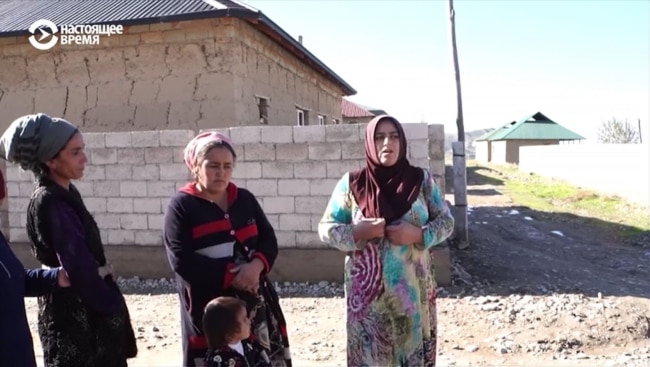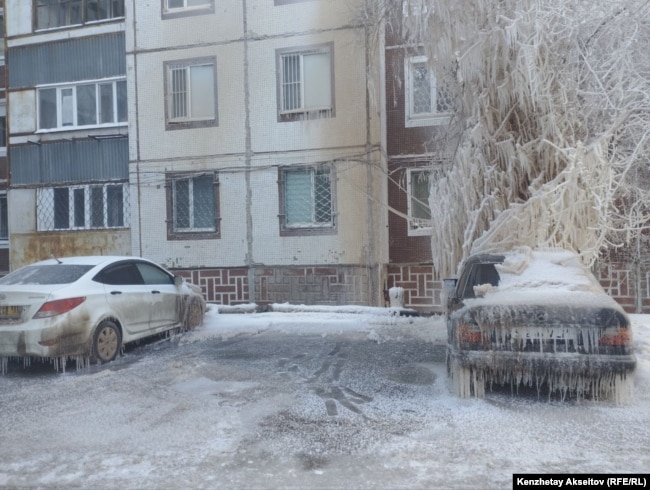People shiver inside their homes after a power-plant failure in Kazakhstan. A village in Tajikistan can’t pump water due to blackouts. Streetlight are used in a “restricted” capacity in the Uzbek capital, Tashkent.
Not for the first time, the cold season is throwing Central Asia’s energy shortages into sharp relief and giving hurting populations more reasons to be angry with their governments during an economic crunch.
“The shortages are caused largely by mismanagement,” Alisher Khamidov, an expert based in the Kyrgyz capital, Bishkek who consults on development projects, told RFE/RL. “There are huge losses of electricity, up to 40 percent in some of these countries, because the grid networks are so outdated and governments have not renovated them in years.”
Nothing Left To Spare?
In Safarmoh Bobohonova’s village 10 kilometers from the Tajik city of Kulob, daytime electricity came to a halt when scheduled blackouts began in October.
But that was the least of her problems, she told RFE/RL’s Tajik Service. “The water pump needs electricity to work. And so we haven’t had water for a month,” Bobohonova said.

In settlements around Tajikistan — although not in the big cities — annual blackouts are growing longer from week to week and are forcing residents to turn to coal.
Yet amid across-the-board inflation, coal prices have spiked 20 percent this year — a situation that traders told RFE/RL had been exacerbated by increases in road tolls levied by an omnipotent toll-collecting company.
But it is Central Asia’s most energy-rich country that has provided the most stunning evidence of the energy collapse this winter.
Ekibastuz, a city of 150,000 people in northern Kazakhstan, sits close to two of Central Asia’s largest coal mines and just 15 kilometers from a power station that supplies around 15 percent of the country’s energy.
Yet the smaller, privately owned power station that supplies the city itself and is now almost 70 years old broke down on November 27, just as temperatures plunged to -30 degrees Celsius.
In the days since the crash, footage has shown residents preferring to stand by fires instead of freezing in their apartments or face a crush to try and get an electric heater.

Residents of the northeastern city of Oskemen have also reported central-heating issues. A representative of the power station told RFE/RL’s Kazakh Service that plans to expand the station to meet growing demand were interrupted by geopolitical fallout from Russia’s invasion of Ukraine, with a Russian supplier unwilling to supply parts for the rebuild.
Four of the five Central Asian countries — gas-rich, information-scarce Turkmenistan being the exception — have suffered power shortages in the last month.
Uzbekistan witnessed rare — if small — provincial protests over power shortages two years ago, and the shortages are looking similarly acute this year.
In the first half of November, a key fertilizer plant in the agriculture-rich Ferghana region ended production nearly two months ahead of schedule due to gas shortages, employees of the Ferganaazot company complained to RFE/RL’s Uzbek Service.

In Tashkent, the state company responsible for street lighting in the capital explained that nighttime illumination of central streets would be “restricted” from November 16. “We hope residents and guests of Tashkent will understand the temporary inconveniences in the…night and will also take an active part in solving the common problem of using electricity rationally and optimally,” the Toshshaharnur company said.
While Kazakhstan and Uzbekistan look to thermal power plants for the biggest share of their energy mix, in Kyrgyzstan and Tajikistan hydropower plays an important role in keeping the lights on.
That makes the volume of glacier-fed reservoirs adjoined to hydroelectric power stations like Toktogul in Kyrgyzstan and Nurek in Tajikistan a perennial worry for the region’s two poorest governments.
But an expert interviewed by RFE/RL’s Tajik Service argues that Tajik electric company Barqi Tojik did not have that excuse this season, suggesting that the rolling blackouts in villages this year reflected Dushanbe’s priorities. “Industrial plants receive electricity in unlimited volumes and we know that electricity is being exported to Afghanistan,” economist Abdurahmon Hakimzade said. “We should satisfy the people of Tajikistan with electricity first.”
Russia’s Offers, Renewables Drive
For the two countries with larger populations and bigger budgets — Kazakhstan and Uzbekistan — energy diversification is a visible priority.
As Ekibastuz froze, Kazakh President Qasym-Zhomart Toqaev was on a visit to Paris, where Kazakhstan and France signed agreements including a nearly $2 billion deal for a wind farm in Kazakhstan’s southern Jambyl region — a part of the country where the power deficit is particularly pressing.
Tashkent has also embarked on a renewables drive and signed deals worth $12 billion with Saudi Arabia in August that included plans for the world’s largest wind farm and other green energy projects.
And Russia, a thorny but long-standing energy partner for the region, does not want to feel left out. Prior to the Kremlin launching an unprovoked, full-scale war in Ukraine in February, Moscow’s Rosatom had offered to build nuclear power stations in both Kazakhstan and Uzbekistan.
But while Rosatom has yet to fall directly under Western-led sanctions, the war has added more than an element of uncertainty to those potential mega-projects.
Earlier this week, the presidential administrations of Russia and Kazakhstan confirmed that Russian President Vladimir Putin had proposed a “three-sided gas union” with Astana and Tashkent during a November 28 meeting with Toqaev in Moscow.
Neither country has thus far given any indication that it wishes to join such a union.
For both states, gas shortages are a straitjacket, not least because they interrupt potentially lucrative trade with China, the region’s biggest purchaser of natural gas.
In June, Sanzhar Zharkeshov, the chief of Qazaqgaz, Kazakhstan’s natural-gas company, warned officials and lawmakers that exports would not be viable next year unless there were radical changes in the sector.
One of the biggest problems, he said, were low domestic gas prices that make extraction unappealing.
This is the same argument made by the Kazakh Energy Ministry, which has complained that low tariffs for heating give power providers — especially private ones — limited incentives to overhaul outdated infrastructure.
But Khamidov, the consultant, says the fatal unrest in Kazakhstan this January ignited by an overnight spike in the cost of liquified petroleum gas (LPG) is an example of why Central Asian leaders will be very cautious about any proposals to increase energy prices for its citizens.
“Governments find it more convenient maintaining Soviet-era centralized subsidies because this keeps people calm, even if the infrastructure is falling apart,” Khamidov said.
On January 25, parts of Kazakhstan, Kyrgyzstan, and Uzbekistan — the three surviving members of the conjoined Central Asia Power System, a Soviet-legacy super-grid — all suffered blackouts in an event that some observers linked to excess demand from a boom in regional cryptocurrency mining.
Source : TheIndianExpress









